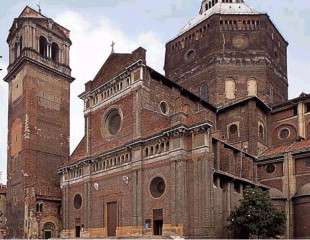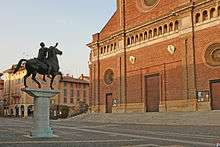Civic Tower (Pavia)
The Civic Tower was built in the Italian city of Pavia in the 11th century, next to Pavia Cathedral. Built to a rectangular footprint, it was 72 metres (236 feet) high.[1]

Between 1583 and 1585 the architect Pellegrino Tibaldi led works to add a room at the top of the tower to house the cathedral's bells, which it did until it was moved to a campanile of the Cathedral.[2]
On 17 March 1989, at 8:55 a.m., the Civic Tower collapsed, leaving 8,000 cubic metres (280,000 cubic feet) of brick, sand and granite rubble.[3] The collapse killed four people and injured fifteen.[4][5][6] It has not been rebuilt, though some elements from it are now on display at the city's Castello Visconteo.[2]
After the towers collapse, the Italian government closed the Leaning Tower of Pisa on 7 January 1990 over concerns that the popular tourist site may also be at risk of collapse.[7][8]
 Remains of the tower (between the statue base and the corner of the Pavia Cathedral).
Remains of the tower (between the statue base and the corner of the Pavia Cathedral).- Close-up of remains with a plaque showing its original form
References
- "Torre Civica (resti)" (in Italian). Lombardia Beni Culturali. Archived from the original on 20 November 2013. Retrieved 4 April 2013.
- Arecchi, Alberto (29 January 2002). "La Torre Civica" (in Italian). Miapavia.
- Bonerandi, Enrico (18 March 1989). "Un Boato E L' Antica Torre Si Sbriciola". La Repubblica (in Italian).
- Montanari, Laura (22 March 1989). "Ma Pavia Ha Ancora Paura". La Repubblica (in Italian).
- Hofman, Paul (1989-07-30). "Italy's Endangered Treasures". New York Times. New York. Retrieved 2020-04-29.
- Montalbo, William D (1989-03-18). "900-Year-Old Bell Tower Collapses in Italy; Three Killed". Los Angeles Times. Los Angeles. Retrieved 2020-04-29.
- "Tipping the Balance". TIME Magazine. 25 June 2001.
- "BBC on this day: 1990: Leaning Tower of Pisa closed to public". BBC News. Retrieved 29 April 2020.
External links
| Wikimedia Commons has media related to Civic Tower (Pavia). |